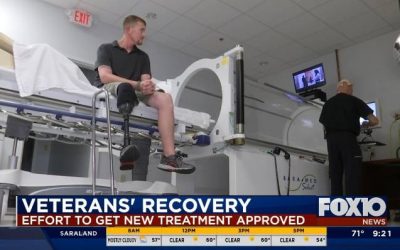Spinal anaesthesia has the advantage that produced nerve block by the injection of local
anaesthetic into cerebrospinal fluid (CSF). However, the greatest challenge in spinal
anaesthesia is to control the spread of local anaesthetic through the CSF to provide a block
which is adequate for the proposed surgery without unnecessary extensive spread, and
increased risk of complications.
Clinical Trial – Measuring Cognitive Enhancement During Hyperbaric Oxygen Treatments
The aim of the current study was to examine the effect of short-term HBOT (hyperbaric oxygen
treatments) on a range of cognitive abilities. The current study examined whether there is a
HBOT-related short-term cognitive improvement and, if so, what specific cognitive abilities
are improved by the intervention.
Participants were randomized to perform cognitive tasks in one of two chambers with two
different clinical environments: (a) HBOT condition: (2 ATA (atmosphere absolute) 100% oxygen
for 90 minutes). (b) Control condition: in which the chamber was not pressurized (Normobaric
condition- 1 ATA for 90 minutes).
Clinical Trial – Effects of HBO on Patients With DM
The purpose of this Research Study is:
1. To determine the reliability and performance of the Dexcom G6® continuous glucose
monitoring (CGM) system in patients with diabetes undergoing hyperbaric oxygen (HBO2)
exposure. The study-specific blood glucose meter and CGM system are approved by the FDA
(U.S. Food and Drug Administration).
2. To determine whether HBO2 exposure causes blood glucose to drop as a result of the
treatment.
3. To determine whether HBO2 causes a change in blood glucagon (a hormone that raises blood
glucose).
Investigators will be comparing changes in blood glucose and glucagon in volunteers with
diabetes who will be exposed to a single hyperbaric oxygen treatment (pressurization to 2.4
atmospheres absolute for 90 minutes) to a control period of 2 hours where volunteers will
simulate a hyperbaric treatment while sitting in an examination room breathing room air at
sea level pressure. Investigators will be measuring blood glucose with a variety of devices
including a continuous glucose monitor, two point-of-care glucometers, and the hospital
inpatient laboratory measurement of venous blood.
Fitness genes of group A streptococci in necrotizing fasciitis and myositis.
Abstract: Necrotizing fasciitis and myositis caused by group A streptococci (GAS) are among the most fulminating infections, with a mortality rate of 20% to 30%. Although numerous regimens have been utilized in attempts to control these devastating infections, such as...
Clinical Trial – the Use of Magnesium Sulfate for Prevention of Postspinal Shivering
Shivering is an unpleasant experience after spinal anesthesia. Shivering is defined as an
involuntary, repetitive activity of skeletal muscles. The mechanisms of shivering in patients
undergoing surgery are mainly intraoperative heat loss, increased sympathetic tone, pain, and
systemic release of pyrogens. Spinal anesthesia significantly impairs the thermoregulation
system by inhibiting tonic vasoconstriction, which plays a significant role in temperature
regulation. Spinal anesthesia also causes redistribution of core heat from the trunk (below
the block level) to the peripheral tissues. These two effects predispose patients to
hypothermia and shivering. The median incidence of shivering related to regional anesthesia
observed in a review of 21 studies is 55%. Shivering increases oxygen consumption, lactic
acidosis, carbon dioxide production, and metabolic rate by up to 400%. Therefore, shivering
may cause problems in patients with low cardiac and pulmonary reserves. The best way to avoid
these intraoperative and postoperative shivering-induced increases in hemodynamic and
metabolic demands is to prevent shivering in the first place. Although magnesium is among
several pharmacological agents used for the treatment of shivering, its effects on prevention
of shivering during central neuraxial blockade have not been evaluated to date. Henceforth,
the aim of this study was to evaluate the effect of magnesiume on shivering during spinal
anesthesia.
Aim:
to compare the efficacy of intravenous versus intrathecal magnesium sulphate for prevention
of post spinal shivering in adult patients undergoing elective lower limb orthopedic
surgeries.
Clinical Trial – Comparing the Effects of Levobupivacaine and Bupivacaine in Saddle Spinal Anesthesia
İn this study; it was aimed to investigate the effects of equipotent doses of hyperbaric
bupivacaine and hyperbaric levobupivacaine in outpatient anorectal surgery under saddle
block. Sixty patients between the age of 18- 50 and in the risk group of ASA I-II included in
the study. 7,5 mg of 0,5% hyperbaric bupivacaine or 7,5 mg of 0,5% hyperbaric levobupivacaine
injected into the intrathecal space in sitting position through L4-L5 or L5-S1 intervertebral
space in 30 seconds. All patients kept in sitting position for 5 minutes with aid after
intrathecal injection and than layed in supine position, finally they positioned in prone
jack-knife. Hemodynamic parameters like NIBP, HR, SpO2, sensory and motor block
characteristics, duration of analgesia, time of first voiding, mobilization time, patient and
surgeon satisfaction, adverse effects and discharge time were recorded during and after
surgery.
The effect of hyperbaric oxygenation therapy on myocardial function
Abstract: Hyperbaric oxygenation therapy is successfully implemented for the treatment of several disorders. Data on the effect of hyperbaric oxygenation on echocardiographic parameters in asymptomatic patients is limited. The current study sought to evaluate the...
Local doctor continues to push VA to approve Hyperbaric Oxygen Therapy for veterans
The AC133 antigen is a novel antigen selectively expressed on a subset of CD34+ cells in human fetal liver, bone marrow, and blood as demonstrated by flow cytometric analyses. In this study, we have further assessed the expression of AC133 on CD34+ cells in hemopoietic samples and found that there was a highly significant difference between normal bone marrow and cord blood versus aphereses (p <0.0001) but not between bone marrow and cord blood. Most of the clonogenic cells (67%) were contained in the CD34+AC133+ fraction. Compared with cultures of the CD34+AC133- cells, generation of progenitor cells in long-term culture on bone marrow stroma was consistently 10- to 100-fold higher in cultures initiated with CD34+AC133+ cells and was maintained for the 8-10 weeks of culture.
Clinical Trial – Subarachnoid Bupivacaine in Obese Patients Undergoing Cesarean Delivery
This study evaluates the effect of subarachnoid hyperbaric bupivacaine on mean arterial blood
pressure (MAP) of pregnant patients with obesity undergoing cesarean section half of the
patients will receive subarachnoid hyperbaric bupivacaine at a dose of 5 mg while the other
half will receive a dose of 10 mg
Clinical Trial – Use of Intrathecal Analgesia in Appendectomy
Acute appendicitis which is the most common cause of acute abdominal pain, is an acute
inflammation of appendix vermiformis. Appendectomy operations can be performed as
laparoscopic and open surgery. Addition of opioids to intrathecal local anesthetics to
improve the quality of preoperative analgesia is an increasingly used method in recent years.
The aim of this study is to compare bupivacaine-fentanyl and bupivacaine-alfentanil which are
used intrathecally to create motor and sensory block. 50 volunteer patients who were
diagnosed as appendicitis by laboratory tests and clinical diagnostic methods in general
surgery clinic and classified as American Society of Anesthesiologists Classification I-II
(ASA Class I-II) aged between 20-60 years scheduled for laparoscopic appendectomy operation,
were included in this study. The patients were randomly assigned into two groups, Group I and
Group II. Patients received spinal anesthesia with either 10 mg heavy bupivacaine (2 cc)+25
mcg fentanyl (0.5 cc) intrathecally (Group I, n=25) or 10 mg heavy bupivacaine (2 cc)+250 mcg
alfentanil (0.5 cc) intrathecally (Group II, n=25).



